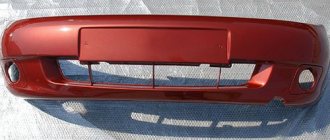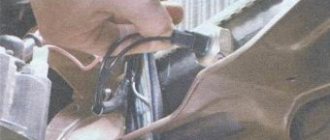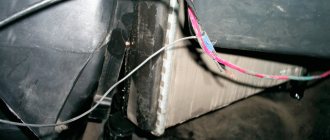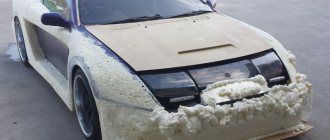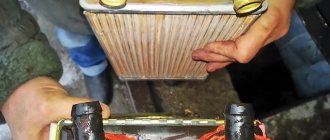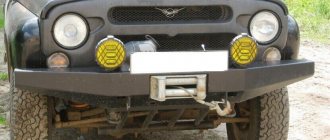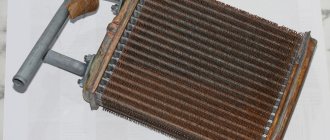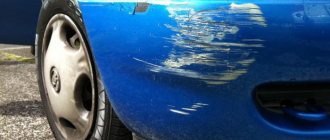The radiator of a car cooling system is a rather fragile element. Regardless of what material the radiator is made of (brass, aluminum, copper, etc.), mechanical damage and corrosion can quickly destroy the cooling radiator.
To protect the radiator you must:
- correctly select and regularly change antifreeze, monitor the proper operation of the entire engine cooling system;
- install additional protective elements (mesh in the radiator grille) to prevent damage to the honeycombs and radiator cells by flying stones and other objects;
It is important to understand that the radiator protection mesh (radiator grille) has both advantages and disadvantages. Also, the radiator mesh must be correctly selected and installed. Read our article for more details.
Radiator protective mesh: what is it for?
Let's start with the fact that radiator corrosion can be prevented through timely maintenance of the cooling system, as well as the use of high-quality antifreeze. As for mechanical damage, the radiator (usually the lower part) is usually damaged by flying stones, branches, etc.
A protective mesh in the radiator grill helps to minimize mechanical damage. Such a grid can have the following installation options:
- integrate into the decorative radiator grille (the mesh is installed on the radiator grille);
- the protection is mounted on the bumper (a protective mesh is placed in the bumper);
As a result, small and rather fragile radiator honeycombs are protected from flying stones, rubble, small branches and other objects accidentally falling under the wheels.
For this reason, many car owners are required to install a mesh to protect the radiator in the bumper, in the standard radiator grille, etc. However, few people wonder why such a useful and effective solution is not installed regularly at the factory on new cars.
Disadvantages of mesh for radiator protection
It may seem that a radiator protective mesh is a necessary item for every car. But this is not true at all. Many automakers strongly do not recommend installing such a net on a car, even to the extent of voiding the car owner’s warranty if this rule is violated.
This is due to the fact that installing such a mesh may prevent the radiator from receiving enough air for normal operation. As a result, this can lead to engine overheating and all the ensuing consequences.
note
This problem is especially real if the mesh is used for a long time without replacement. Small cells become clogged with stones, dry leaves and other debris, causing air to stop flowing through them normally.
In addition to this factor, there are several other disadvantages of such a grid:
- In a collision with, for example, a pedestrian, the front part of the car may not behave as the automaker intended (not crumpling enough, thereby not softening the impact);
- Aesthetic. Not everyone likes the appearance of such a mesh, which often does not fit into the design of the car;
- Reduced aerodynamics. Even if only slightly, a mesh with small cells worsens the aerodynamic characteristics of the car.
Whether or not to install a mesh to protect the radiator is the choice of every car owner. As we noted above, in urban environments this does not make much sense.
( 15 votes, average: 4.80 out of 5)
Where to return or sell old tires
How to restore wipers if they do not clean the glass well?
Related Posts
Why is the radiator mesh not installed at the factory?
A grille mesh is a cheap, simple and common solution. Bumper mesh is available at car markets and stores; buying a radiator mesh or protective grille will also not be a problem. However, new cars do not have any additional radiator protection from the factory.
There are several main reasons:
- protective meshes for radiators are not actually in mass demand and are in demand only in certain CIS countries (for example, the Russian Federation, Ukraine or Belarus);
- When developing various car models, engineers carry out all calculations and tests without a grid. In other words, the presence of any third-party element installed in the path of air flows to the radiator is not assumed and is not taken into account;
- After installation, the mesh (radiator protection) can turn into a barrier to air, as a result of which airflow to the radiator and the quality of the cooling system deteriorate.
The fact is that the protective meshes have small cells to protect the radiator from small stones. At the same time, over time, such cells become clogged with fluff and dirt. The result is that the cooling of the radiator and the entire engine as a whole is impaired, which can be critical for the engine (especially highly forced and very “hot” modern units). - the presence of an additional mesh has an impact on safety in the event of an accident or collision with a pedestrian. Body elements of modern cars (bumpers, grilles, hoods, fenders) must effectively absorb energy, be easily crushed during impacts, and the design must minimize possible injuries to a pedestrian in the event of a collision with him.
Advantages and disadvantages
I have made my choice - next weekend I will equip my machine with a branded mesh. However, minor troubles are possible - I studied the list of them myself and want to share with everyone.
Cooling of the radiator by the incoming air flow after installing the mesh will deteriorate somewhat, and the thermal regime of the motor will change. Well, this is an expected phenomenon. When I installed nets on plastic windows at home, they tried to impose on me an “ideal net” with the smallest cells, through which “nothing could get through at all.” But it is, to put it mildly, difficult for air to pass through such a mesh - it’s easier not to open the window at all... Therefore, you can’t install a completely fine-mesh mesh. True, dirt will still penetrate through large cells. But this, it seems to me, is obvious.
Another disadvantage of the mesh is sometimes called the need for some modifications in the engine compartment. Personally, I intend to contact a service to install the grid - they won’t reinvent the wheel, but will do everything as it should.
Finally, the mesh is accused of having to be washed anyway. Personally, I don't see anything wrong with this. Once again I will refer to the plastic windows in my apartment - twice a year, trained boys remove all the screens and clean them of dirt. It doesn't annoy me.
Have a nice trip, colleagues!
Sincerely yours Sergeich
- The Za Rulem online store is constantly looking for useful car accessories, and during the period of publishing review articles it provides additional discounts of 5% and useful gifts.
The floor goes to the protection of... the radiator!
Radiator grille mesh: to install or not
If radiator protection is needed, mesh is virtually the only solution available. However, taking into account a number of disadvantages, the installation of such protection must be approached with maximum responsibility. It is important to consider the following features:
- Is there an urgent need to install such protection? When driving around the city at low speeds, stones and rubble do not pose a threat to the radiator. Usually the radiator receives mechanical damage when driving on the highway. It turns out that if the car is constantly used within the city, an additional stack is not needed.
- How the mesh will affect the cooling system. The fact is that the mesh under certain conditions can become a serious barrier to air, which will lead to overheating of the engine. In this case, overheating is much more serious than damage to the radiator from stones.
- How will the mesh be attached? It is necessary to take into account all the features of the implementation of fasteners in advance, since there is a risk of damaging the radiator itself. Also, in the event of an accident, non-standard fasteners can cause additional damage to the car with unpredictable consequences.
For these reasons, it is necessary to take into account the individual characteristics and operating conditions of a particular vehicle. In practice, it is usually advisable to install radiator protection on cars that are usually used for highway driving, and are also used in regions where summer temperatures are not the highest. However, in this case there are nuances.
We also recommend reading the article about why a car engine overheats. From this article you will learn about the main problems that cause engine overheating, as well as how to detect and fix the problem.
As a rule, if the car does not have a complex and technologically advanced engine with high output with a small displacement, when installing a mesh, the risks of overheating are not so high.
The main thing is to keep the radiator protective mesh clean and regularly wash the cells with a high-pressure washer. If the motor is forced and the motor is quite heavily thermally loaded, it is better to refuse to install any protection in this case.
What are they and what are they made from?
Today, there are two types of grating mesh. They can be:
- Factory - purchased at car dealerships for specific car models;
- Homemade - made by car owners.
As a rule, production uses a metal mesh (but with different cell sizes) or durable plastic, which is almost indestructible when exposed to low temperatures. According to the fastening method, they can also be divided into two categories:
- Rigid fastening to the decorative part of the car. Ties or bolts can be used;
- Removable for easy removal for cleaning.
Note! Experienced car enthusiasts recommend “rigid mounting” to eliminate rattling. They won't fall off, they won't rub anything, sitting rigidly.
It would be rational to make such improvements when frequently traveling between cities along highways, especially in the summer. The whole point is that modern cars have large radiators (they can go very down) and double grilles should perform a protective function. It is attached between the headlights, and the second one is built into the bottom of the bumper by many manufacturers. But why sometimes bars don’t help at all?
The answer is simple: modern grilles increasingly serve a decorative function; they are made up of large cells, into which not only flies can get, but also stones accidentally thrown out from under the tires of a car driving in front of your car. These factors can damage the surface of the radiator. It’s not so easy to break through it, but it’s quite possible to get clogged with insects and dust. The decision to attach a protective grille is a smart move. Unnecessary charms will settle on it, and you can get rid of them at a car wash.
Recommendations
As a rule, if a mesh is installed on a bumper or a protective mesh is integrated into the upper radiator grille, many owners try to attach such a mesh as discreetly as possible, but reliably. For this reason, a variety of mounting options are used.
Please note that the use of self-tapping screws, latches or fasteners, staples, as well as various types of glue is not recommended. The best way to secure the protective mesh is with simple plastic clamps. Such fasteners are elastic and convenient; if necessary, the mesh can be quickly removed.
We also recommend reading the article on how to flush the engine cooling system with your own hands. From this article you will learn about available methods for flushing the radiator and cooling system.
Let us also add that often to install the radiator mesh you will need to remove the front bumper. It should be borne in mind that modern cars have a lot of additional equipment, which is also integrated into the front bumper area.
For this reason, it is not recommended to remove the bumper unless absolutely necessary, and in case of removal, you must be careful (there is a risk of breaking the latches and fasteners). You should also properly disconnect all electrical connectors and make good connections during reassembly.
